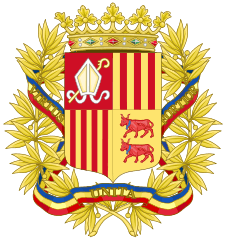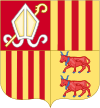Co-Princes of Andorra
The co-princes of Andorra or the co-monarchs of Andorra are jointly the head of state (cap d'estat)[1] of the Principality of Andorra, a landlocked microstate lying in the Pyrenees between France and Spain. Founded in 1278 by means of a treaty between the bishop of Urgell and the French Count of Foix, this unique diarchical arrangement has persisted through medieval times to the 21st century. Currently, the bishop of Urgell (Joan Enric Vives Sicília) and the president of France (Emmanuel Macron) serve as Andorra's princes, following the transfer of the count of Foix's claims to the Crown of France and, thence, to the president of France. Each prince appoints a personal representative, the French prince currently being represented by Patrick Strzoda and the Episcopal prince by Josep Maria Mauri.[2]
| Co-Monarch of Andorra | |
|---|---|
| Catalan: Co-Príncep d'Andorra French: Co-Prince d'Andorre Spanish: Co-Príncipes de Andorra | |
 Coat of arms of High Authorities of Andorra | |
| Incumbent | |
.jpg) | |
| Joan Enric Vives Sicília since 12 May 2003 | |
| Co-incumbent | |
.jpg) | |
| Emmanuel Macron since 14 May 2017 | |
| Details | |
| Style | His Excellency |
| First monarch | Pere d'Urtx Roger-Bernard III |
| Formation | 1278 |
| Residence | La Seu d'Urgell Cathedral (Spain) Élysée Palace (France) |
| Appointer | The Pope (for life) French citizens (five years, renewable once) |
 |
|---|
| This article is part of a series on the politics and government of Andorra |
| Constitution |
|
Executive
|
|
Legislature |
|
|
|
|
|
Origin and development of the co-principality
Tradition holds that Charlemagne granted a charter to the Andorran people in return for their fighting against the Moors. The feudal overlord of this territory was at first the Count of Urgell. In 988, however, the count, Borrell II, gave Andorra to the Diocese of Urgell in exchange for land in Cerdanya.[3] The bishop of Urgell, based in Seu d'Urgell, has ruled Andorra ever since.[4]
Before 1095, Andorra did not have any type of military protection, and since the bishop of Urgell knew that the Count of Urgell wanted to reclaim the Andorran valleys,[4] he asked for help from the lord of Caboet. In 1095, the lord and the bishop signed a declaration of their co-sovereignty over Andorra. Arnalda, daughter of Arnau of Caboet, married the viscount of Castellbò, and both became viscounts of Castellbò and Cerdanya. Their daughter, Ermessenda,[5] married Roger Bernat II, the French count of Foix. They became, respectively, count and countess of Foix, viscount and viscountess of Castellbò and Cerdanya, and also co-sovereigns of Andorra (together with the bishop of Urgell).
In the 11th century, a dispute arose between the bishop of Urgell and the count of Foix. The conflict was mediated by Aragon in 1278, and led to the signing of the first paréage, which provided that Andorra's sovereignty be shared between the count[4] and the bishop. This gave the principality its territory and political form, and marked the formal commencement of Andorra's unique monarchical arrangement.
Through inheritance, the Foix title to Andorra passed to the kings of Navarre. After King Henry III of Navarre became King Henry IV of France, he issued an edict in 1607 establishing the king of France and the bishop of Urgell as co-princes of Andorra. In 1812–13, the First French Empire annexed Catalonia and divided it into four départements, with Andorra forming part of the district of Puigcerdà (department of Sègre). Following the defeat of Napoleon I, a royal decree reversed this annexation, and Andorra reverted to its former independence and political state.[6][7][8] The French head of state—whether king, emperor, or president—has continued to serve as a co-prince of Andorra ever since.
Recent history
On 12 July 1934, Andorra's monarchical system was challenged by an adventurer named Boris Skossyreff, who issued a proclamation in Urgell declaring himself "Boris I, King of Andorra".[9] Though initially enjoying some support within Andorra's political establishment, he was ultimately arrested by Spanish authorities on 20 July of that year after declaring war on the bishop of Urgell (who had refused to relinquish his own claim to the principality). Skossyreff was expelled, and was never considered to have been the Andorran monarch in any legal sense.
Before 1993, Andorra had no codified constitution, and the exact prerogatives of the co-princes were not specifically defined in law. In March of that year, a Constitution was approved by a vote of the Andorran people and signed into law by the two reigning co-princes at the time: President François Mitterrand and Bishop Joan Martí Alanis. It clarified the continuance of the unique Andorran monarchy, and also delineated the precise role and prerogatives of the two co-princes. Prior to adoption of the Constitution, Andorra paid in odd-numbered years a tribute of approximately $460 to the French ruler, while on even-numbered years, it paid a tribute of approximately $12 to the Spanish bishop, plus six hams, six cheeses, and six live chickens. This medieval custom was subsequently abandoned in 1993.[10]
In 2009, French president Nicolas Sarkozy threatened to abdicate as co-prince if the principality did not change its banking laws to eliminate its longstanding status as a tax haven.[11]
Contemporary political role
The Constitution of Andorra carefully defines the exact role and prerogatives of the co-princes of Andorra today. The constitution establishes Andorra as a "parliamentary coprincipality",[12] providing for the president of France and bishop of Urgell to serve together as joint heads of state.[13] The constitution distinguishes between which powers they may exercise on their own (Article 46), and which require the countersignature of the head of the Andorran government, or the approval of the "Síndic General", the Andorran legislature (Article 45).
Powers the princes may exercise on their own include:[14]
- Joint exercise of the "prerogative of grace" (the power to pardon);
- Each co-prince may appoint one member of the Superior Council of Justice and one member of the Constitutional Tribunal;
- Establishment of such services as they deem necessary to fulfil their constitutional prerogatives, and appointment of individuals to fulfil these services;
- Requesting a preliminary judgement about the constitutionality of proposed laws, or of international treaties;
- Agreeing to the text of any international treaty, prior to submitting it for parliamentary approval;
- Bringing a case before the Constitutional Tribunal in the event of any conflict over the exercise of their constitutional prerogatives.
Powers the princes may exercise in conjunction with the head of government include:[15]
- Calling for elections or referendums in accordance with constitutional provisions;
- Appointing the head of government in accordance with constitutional provisions;
- Dissolve the General Council (the Andorran legislature) prior to the expiration of its current term (but not until at least one year has passed since the prior election);[16]
- Accrediting diplomatic representatives from Andorra to foreign states, and receive credentials of foreign representatives to Andorra;
- Appointing office-holders in accordance with appropriate constitutional provisions;
- Sanctioning and enacting laws in accordance with constitutional provisions;
- Granting formal consent to international treaties, once ratified by the General Council.
Each prince is granted an annual allowance by the General Council to dispose of as he or she sees fit.[17] Each appoints a personal representative in Andorra,[18] and in the case of incapacitation of one of them, the constitution provides for the other prince to govern in his or her absence, with the concurrence of the Andorran head of government or the General Council.[19]
Certain treaties require the participation of the co-princes (or their designated representatives) in their negotiation process as well as their final approval; these are detailed in Articles 66 and 67 of the constitution.
The co-princes jointly retain the right to propose amendments to the constitution; this same right rests with the General Council.[20] They have no veto power over legislation passed by the General Council, though they do retain a veto over certain international treaties, as described above.
List of rulers
References
- "The constitution of the Principality of Andorra". www.andorramania.com.
- "Why is the President of France Co-Prince of Andorra?". Royal Central. 7 October 2019. Retrieved 9 November 2019.
The President of France, Emmanuel Macron, serves as Co-Prince of Andorra in addition to his duties as French President and is one of the few examples of a democratically elected leader serving in a royal capacity in another country. Since 2003, the other Co-Prince is the Catholic Bishop of Urgell from Spain, Joan-Enric Vives i Sicília.
- "La formació d'Andorra". Gran Enciclopèdia Catalana. Enciclopèdia Catalana. (in Catalan) English version
- Things about the history of Andorra Archived 9 February 2010 at Archive.today French Co-prince (in Catalan)
- "Ermessenda de Castellbò". Gran Enciclopèdia Catalana. Enciclopèdia Catalana. (in Catalan) English version
- Armengol Aleix 2009, p. 172.
- Guillamet Anton 2009, p. 172.
- Armengol Aleix 2009, p. 342, 343.
- Events, Issues 19-24, page 46, 1938
- Andorra: Septicentennial for a Ministate, from Time, 30 October 1978.
- Sarkozy threatens to renounce Andorran title.
- Constitution of Andorra, 1:4.
- Constitution of Andorra, 43:1-2.
- Constitution of Andorra, Article 46.
- Constitution of Andorra, Article 45.
- Constitution of Andorra:45:1:E and 71:1-3.
- Constitution of Andorra, 47.
- Constitution of Andorra, 48.
- Constitution of Andorra, 45:3.
- Constitution of Andorra, 105.
Bibliography
- Armengol Aleix, E. (2009). Andorra: un profund i llarg viatge (in Catalan). Andorra: Government of Andorra. ISBN 9789992005491.CS1 maint: ref=harv (link)
- Guillamet Anton, J. (2009). Andorra: nova aproximació a la història d'Andorra (in Catalan). Andorra: Revista Altaïr. ISBN 9788493622046.CS1 maint: ref=harv (link)
External links
- Representació de S.E. El Copríncep Francés
- El Copríncep d'Urgell
- Rulers.org – Andorra list of rulers for Andorra
